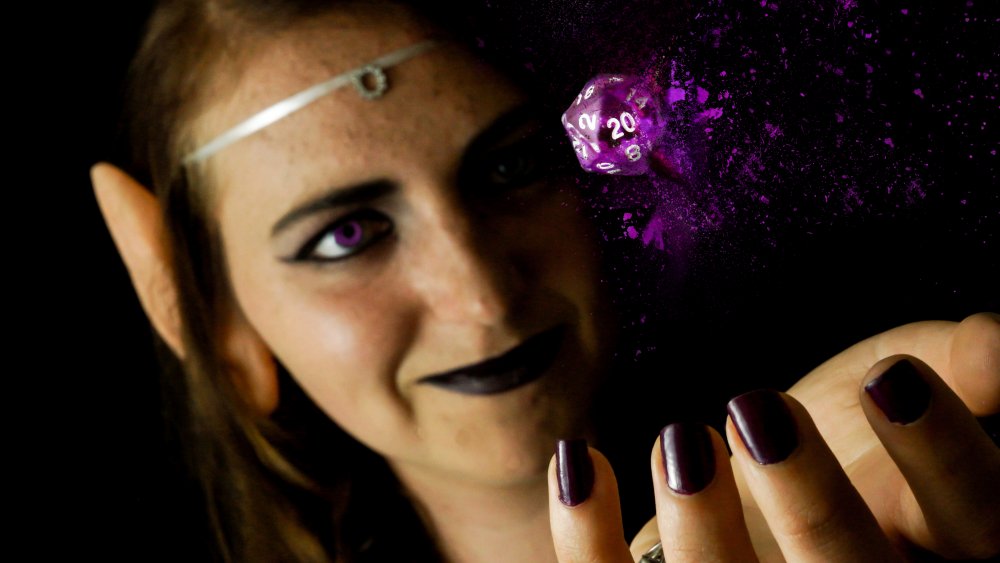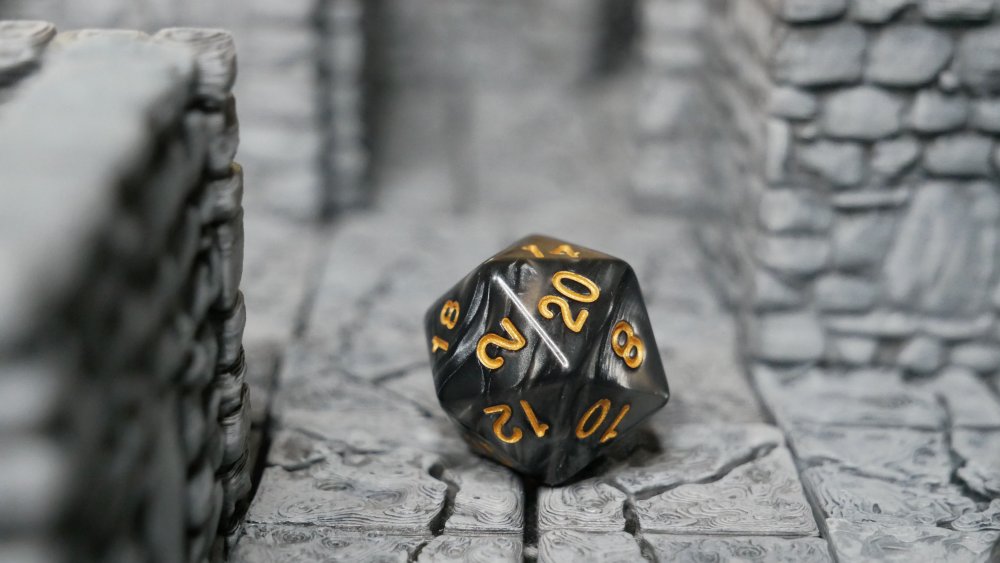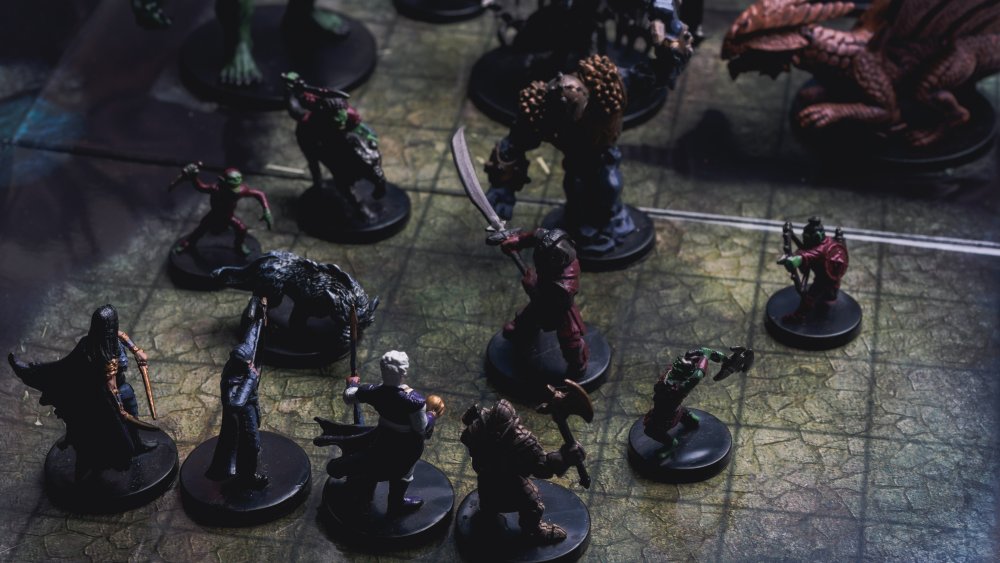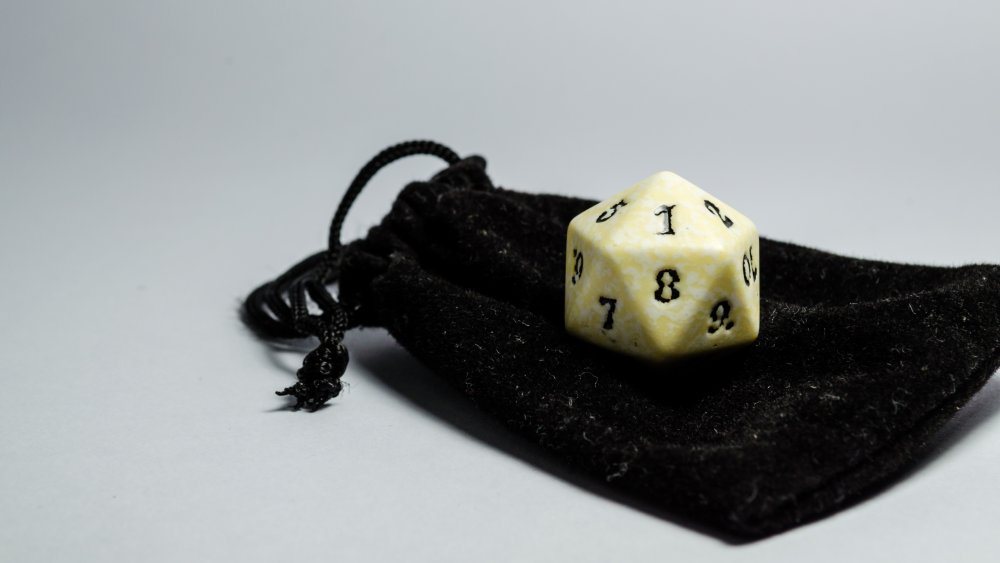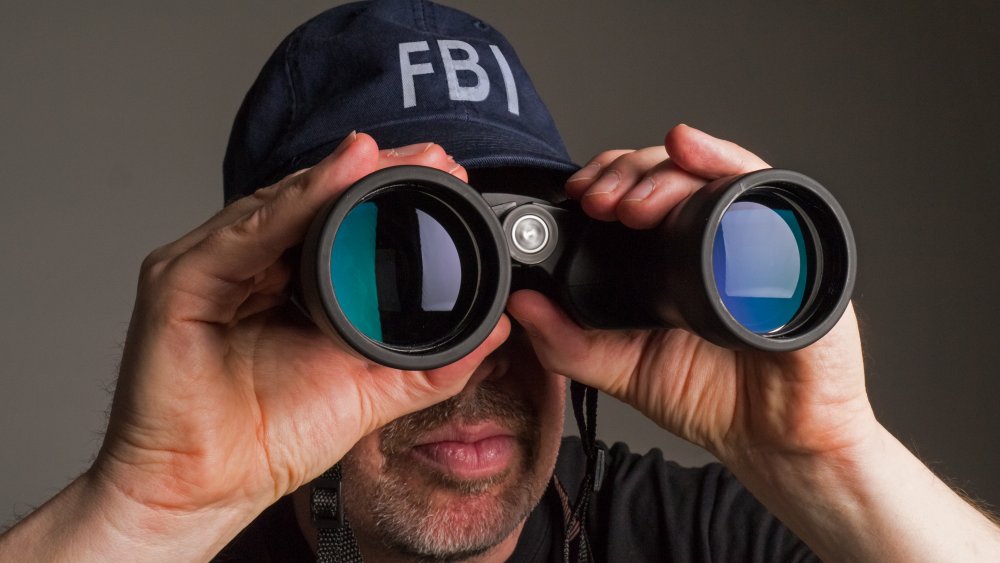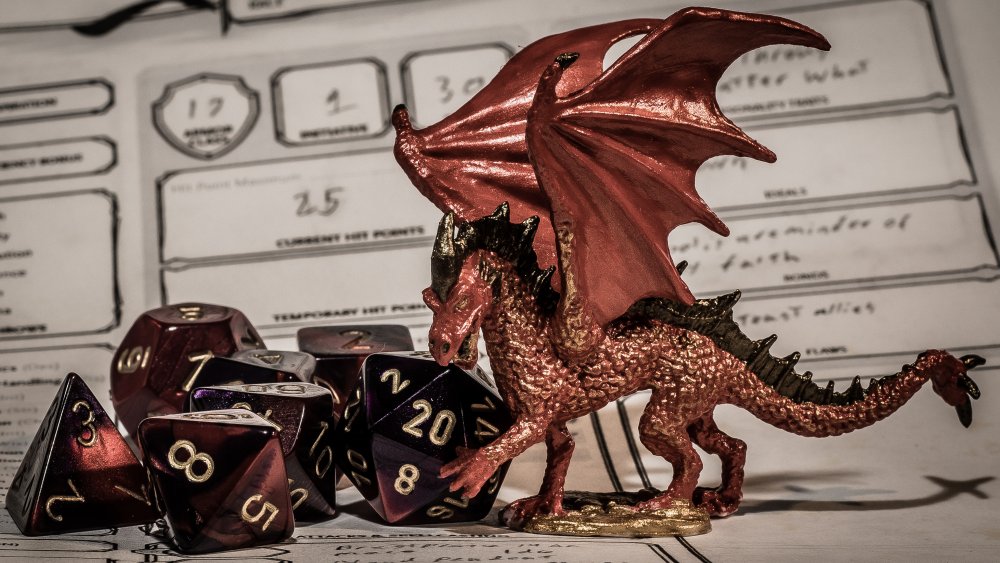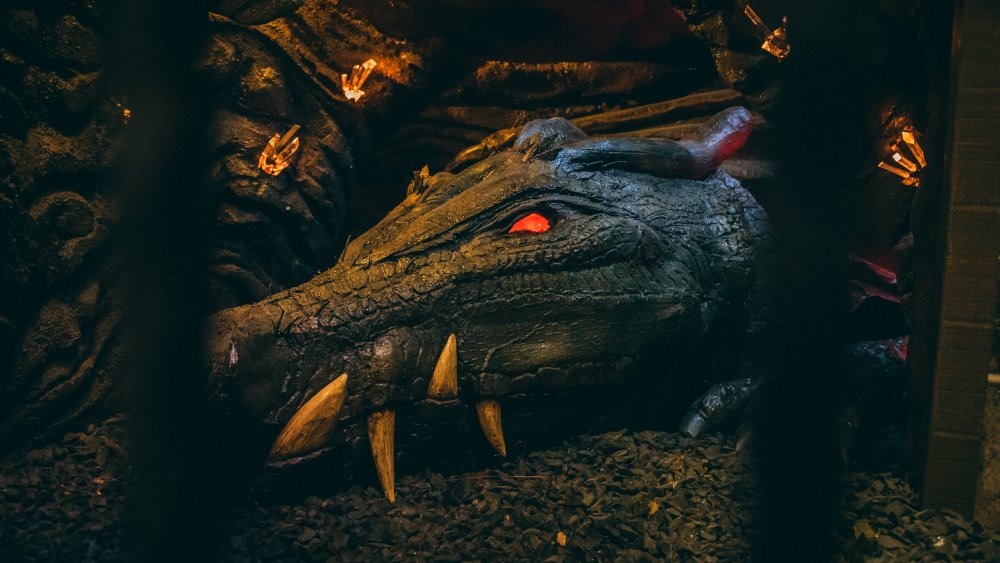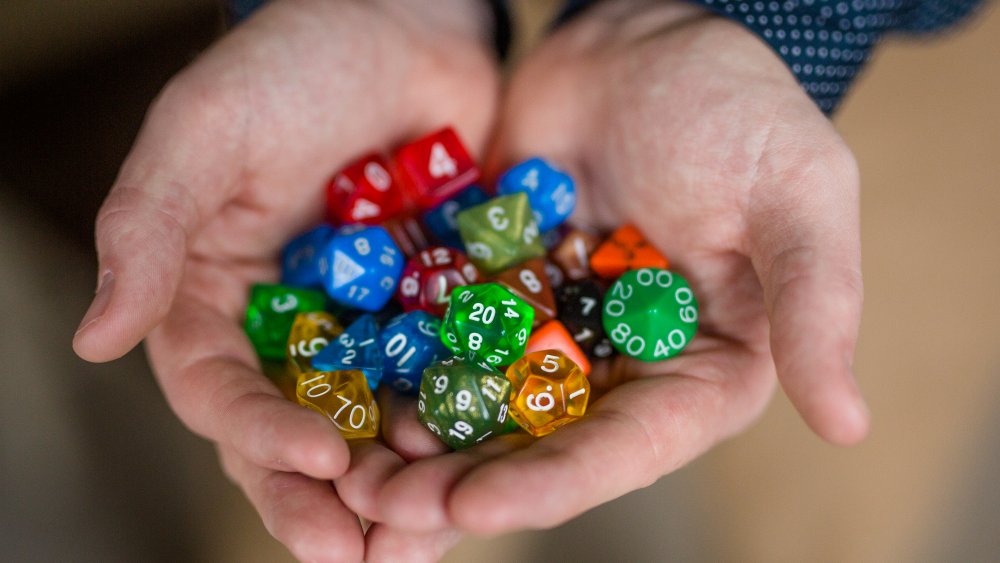The Controversial History Of Dungeons & Dragons
Ask anyone if they play D&D, and one of two things will happen: you'll get a baffled look and a denial, or an enthusiastic "Yes!" followed by a character name, class, and in-depth explanation of the most awesome thing they've ever done.
Dungeons & Dragons (D&D) inspires some seriously devout fans. Why? Because it's epic. While the 21st century world might surround us with fantastic movies, endless binge-watching opportunities on your streaming network of choice, and an equally endless world of entertainment on the internet, there's something even more endless: imagination, like a group's creativity when it comes to figuring out how to hack magical abilities to set someone on fire in new and interesting ways.
Today, games like Dungeons & Dragons are a little more mainstream than they have been historically. During the 1980s and 90s, it wasn't just a matter of being called a geek or a nerd, there was a very real moral panic that raged over D&D. Some believed it was teaching people how to tap into the unknown to cast real spells and summon real demons, and honestly, if that was the case, there would be a lot more demons walking the earth and a lot more half-orc, half-elf children running around. So why, exactly, was Dungeons & Dragons condemned as a tool of the devil? It's a very strange story, indeed.
The disappearance of a Dungeons & Dragons-loving prodigy
The spark that ignited an entire movement against Dungeons & Dragons happened on August 15, 1979.
That, says the Saturday Evening Post, is the day a teenage college student, child prodigy, and D&D player named James Dallas Egbert III disappeared, leaving behind a suicide note. Police were called, and a private investigator named William Dear also got involved in the search. Dear was less interested in the pressures of being a young college student and rumors of drug use than he was with a map of the college campus and the fact the missing teen played D&D. Dear came to the conclusion he had entered steam tunnels under the school, probably in something of a fugue state caused when he lost track of the line between reality and game.
Eventually, Egbert returned, admitting he had woken up from his suicide attempt and fled the state. He said he had done it because of academic and parental pressure, but as far as the public was concerned, it was all about the D&D. In 1981 — a year after Egbert did ultimately take his own life — a Cosmopolitan journalist wrote Mazes and Monsters based on the case. It would get turned into a movie starring a young Tom Hanks, and when Dear released his own book in 1984, it didn't matter he downplayed any connection Dungeons & Dragons might have had — that part of the story had already been written.
The tragic death of Irving Lee Pulling
Tragically, Egbert's wasn't the only suicide linked to Dungeons & Dragons. In 1983, the parents of Irving Lee Pulling II sued their son's high school principal after Pulling completed suicide on the day before finals, 1982. According to The Washington Post, an investigation by the sheriff's department turned up a ton of D&D "paraphernalia," including a magazine and a note with words they didn't understand. More to the point, classmates said Pulling had difficulty fitting in, and suffered from depression.
At any rate, his parents sued the school for allowing them to play D&D there, including the last session when another player supposedly "cursed" Pulling. Within just a few months of filing, a Virginia judge dismissed the suit, but not because of anything directly related to D&D. It was dismissed because the principal had been acting as a government official while doing his job, and couldn't be sued as an individual.
Patricia Pulling wasn't about to give up, and The Village Voice says that's when she launched a crusade against the game. She founded Bothered About Dungeons & Dragons (BADD), probably not realizing what a stereotypical paladin she was: wielding the sword of truth against the darkness, telling everyone all about the evils they were going to fall victim to, and actually welcomed at the table by absolutely no one.
If you or anyone you know is having suicidal thoughts, please call the National Suicide Prevention Lifeline at 1-800-273-TALK (8255).
BADD to the bone
Patricia Pulling's crusade against Dungeons & Dragons was a major one, and she wrote her own books about the game she believed promoted things like insanity, blasphemy, cannibalism, and demon summoning. For real, says The Village Voice, and she also claimed D&D was one of the country's leading causes of teen suicide. Clearly, something needed to be done.
Pulling was there, brandishing her sword and pulling a seemingly infinite number of claims out of her own Bag of Holding like there was no tomorrow. She even published a list of behaviors that were signs D&D had exerted its mighty hold over curious child. What should Mom and Dad be on the lookout for? If little Junior started grave robbing, stealing religious artifacts, drinking blood, signing suicide pacts, or exhibiting "supremacist attitudes," D&D might be infiltrating your home. Quick, roll a save vs. poison!
She profiled kids who were particularly vulnerable to D&D, saying it was the intelligent, adventurous, creative kids with no history of drug use or behavioral problems who usually fail their saving throws and get sucked in. So ... pretty much everyone's ideal kid was a candidate for Dungeons & Dragons domination. She wasn't alone in her beliefs, either: she appeared on television shows across the 80s dial, and even sat down with creator Gary Gygax on an episode of 60 Minutes (via the BBC). Sure, she was misinformed, but who needs the truth when you've got Shield of Faith to get you over those pesky speed bumps?
The 'Dungeons & Dragons is a mind game' defense
Most Dungeons & Dragons players will say there's nothing dangerous about it — unless you count the possibility of getting pizza sauce on your Player's Handbook, and in that case, the danger is very real. But in 1984, one player spoke out against D&D, and said it was responsible for leading him down the path that ended with the murder of 18-year-old Mary Towey.
According to the Associated Press, Darren Lee Molitor was 19 when he was convicted of killing Towey in 1985. He claimed that his trial had been unfair because he hadn't been able to enter D&D as a defense. According to him, D&D had taught him just how effective mind games were — and that's what he had intended to play with Towey.
He even wrote a whole essay on it (via The Escapist). He described rolling up a "newborn character" who would become real ... in your head. The game was guided by a dungeon master (DM) he described as "god," claimed it was "a device of Satan to lure us away from God," and playing three to five times a week for up to eight hours at a time had accustomed him to the violence his character acted out in game. It sounds very similar to claims that would be made about video games years later, but the biggest, most shocking thing he wrote? The idea a game group could get together that often and for that long.
Writing the spellbook for American fundamentalism
It was mainly the devoutly religious and the ultra-conservative who rallied against Dungeons & Dragons, and here's the weird thing — fast forward a few decades, and it's not just about the perceived evils of rolling dice and trying to add under pressure. Vox argues D&D's naysayers — and one in particular — helped lay the foundation for American fundamentalism in the Trump era.
Jack Chick was a California-based cartoonist who published a ton of tracts about everything that was going to get you condemned to Hell. That ranged from playing D&D to being Mormon, Catholic, a feminist, or going trick-or-treating, and he was all sorts of fire-and-brimstone when it came to his illustrations. (He considered himself an Independent Baptist.) When he died in 2016, there was an outpouring from people who said their childhoods had been traumatized by him, who had grown up convinced they were doomed to eternal suffering because there was just so much they could do wrong.
Dungeons & Dragons was demonized by the cartoonist that had once dubbed the Eucharist "The Death Cookie," and his Dark Dungeons comic claimed D&D was just a way for a DM to decide who got to learn the real spells, become the real wizards, and really raise the dead. Chick discovered how to tap into what America was really worried about, sensationalize it, and make people feel even more justified in their fear and hate — a skill that's been perfected in the 21st century, says Vox.
Dungeons & Dragons bounced back when research was done
Things were looking pretty dire for Dungeons & Dragons. They were standing against everyone from Hollywood to conservative groups like BADD, and they even had some professional psychiatrists saying there was some serious danger there — and not just from shapeshifting mimics. Parents were warned to protect their children ... so what's a 2nd-level wizard to do?
At the heart of the matter were recovered memories. That's the phenomenon where, say, someone suddenly remembers the DM told them they had to sacrifice their neighbor's cat if they wanted their character to survive, when in reality, up until it was suggested to them, they hadn't remembered anything of the sort. According to Psychology Today, there were only a few psychiatrists who spoke out and condemned these recovered memories, and they often found themselves at the center of a witch hunt, too.
It wasn't until the mid-1990s law enforcement begam to come out with the truth — there were no Satanic cults, there was no widespread abuse, there were no recovered memories. It coincided with D&D players who had started as teens growing up and becoming professionals themselves, and speaking out on behalf of a game that, at worst, taught them problem-solving and creative thinking.
The Dungeons & Dragons module that was released and recalled on almost the same day
Sure, old-school Dungeons & Dragons was a little racy. But there was one module so graphic it was pulled from circulation almost the same day it hit the market. It was called The Palace of the Silver Princess, and anyone who has a version of this with an orange cover, congratulations: you've got the Silver Princess in all her glory. The story, Wired says, it a weird one — and it was happening in the early 80s. Writer Jean Wells was asked to create a basic intro module to the game, and what she ended up writing was a module based on her own character, which became what artist Bill Willingham called her own "private fantasies."
Add in a Easter egg of a weird set of 3-headed monsters that just happened to look like caricatures of employees alluding to company unrest, and you have a recipe for disaster. But since Wells was good friends with both creator Gary Gygax and creative head Lawrence Schick, her work simply got pushed through.
It wasn't until after it was printed and sent out for distribution that management actually looked at what it was, and that's when the bugbear poop really started to fly. There was an instant recall put out, employees scrambled to hide copies, and those that weren't hidden ended up buried at a Lake Geneva landfill along with, presumably, a heck of a lot of pride.
The 'Dungeons & Dragons murders'
The News & Observer called them "the Dungeons & Dragons murderers," and they did, indeed, play D&D. That's largely why the murder case got national attention; it happened in 1988, when the moral panic was still going strong, and haters who were determined to bring down D&D were quick to ignore other evidence and blame the game.
Here's the basics (via The New York Times): In July 1988, Leith and Bonnie Von Stein were attacked in their bed. Bonnie suffered life-threatening injuries but survived, while her husband was killed. It was ultimately found the motive was Leith's recent million-dollar inheritance, and the murder? His stepson was behind it.
Chris Pritchard regularly used the members of his D&D game group as a sort of sounding board for the rage he felt toward his stepfather, and when police headed to North Carolina State University to get the truth, History says other players pointed to James Upchurch and Neal Henderson, who were also D&D players. All three were arrested, put on trial, and found guilty — Henderson was paroled in 2000, Pritchard in 2007, and Upchurch is first eligible for parole in 2022. Meanwhile, Dungeons & Dragons got another strike against it.
The FBI once investigated Dungeons & Dragons players in connection with the Unabomber
In 2016, CJ Ciaramella filed a FOIA request to make FBI records concerning Dungeons & Dragons' original parent company, TSR, available to the public. The documents revealed the FBI took a strange interest in D&D, TSR, and creator Gary Gygax.
First, the little Wisconsin town where D&D was born was once under surveillance due to the presence of "significant cocaine traffickers." Which is weird, because cocaine isn't the first thing you think of when you think "gaming snacks." And don't worry, it gets weirder, notes Polygon. The cocaine thing was in 1983, and in 1995, the FBI put some serious effort into investigating a group of players they were convinced had something to do with the Unabomber. Yes, that guy.
The players were referred to as "known members of the Dungeons and Dragons," which makes it sound like there's less dice and more motorcycles involved than there really are. Gygax was described as "eccentric and frightening," and the FBI actually visited the gamers, showed them Unabomber-centric sketches, and asked if anyone recognized anything. Group members became "paranoid," and in all fairness, who wouldn't be freaked out? Agents ended the documents with the sentiment they were "quite sure that some of the members of the group fantasized about the possibility that maybe one of their members was responsible for the bombing," and it just goes to show real life is stranger than anything out of the Monster Manual.
A Wisconsin prison deemed Dungeons & Dragons 'gang activity'
Surely, all that paranoia is in the distant past, right? Like... the 1980s? Not quite, and in 2004, inmates at the Waupun Correctional Facility had their books, character sheets, and dice confiscated. Why? According to SyFy Wire, Waupun officials claimed Dungeons & Dragons constituted and encouraged "gang activity," and they couldn't have any of that going on.
Insane, right? The inmates thought so, and appealed. (It's no wonder, just imagine what kind of campaign someone could organize from a jail cell!) The courts didn't make a final decision until 2010, when the United States Court of Appeals basically said since there was no proof it didn't lead to gang activity, they were upholding the ban. According to The New York Times, there was also absolutely no evidence it did lead to gang activity, and many people pointed out — including George Mason University law professor Ilya Somin — there really should be concrete evidence something is dangerous before it's banned. Clearly, a lawful neutral character if there ever was one.
The abuse claims directed at a 5e consultant
Dungeons & Dragons' current parent company, Wizards of the Coast, was hit with a massive scandal that started from within their own ranks in early 2019. Zak Smith, an artist and game designer who has consulted on numerous D&D projects, was the subject of a series of terrible allegations. A number of women had stepped forward to say they had suffered sexual, mental, and physical abuse from him, most who worked with him on a 2010 D&D-related video series called I Hit It With My Axe.
Within a few days of victims coming forward with their allegations, WoTC issued a statement saying Smith's name would be removed from all future printings of Dungeons & Dragons materials. They also went on to say they were 100 percent behind a movement started by the digital retailer OneBookShelf, which said a portion of the proceeds from the sales of Smith's existing titles — and WoTC's Dungeon Masters Guild bundle — would go directly to the non-profit RAINN.
Dungeons & Dragons is now used as therapy
When Patricia Pulling sued her son's school for allowing the kids to play Dungeons & Dragons, they were quick to distance themselves from it. How times have changed. KQED News took a look at one of Kyle Callahan's students at LiHigh School — a school for students suffering from various behavioral difficulties. One of his students asked to play, and he had this to say about it: "Without a doubt, D&D has been one of the most successful classes we've offered at LiHigh School. Students love it, staff love it, and it genuinely helps the students achieve their social-emotional goals."
It makes sense. Take a student who has difficulty working with their peers, give them a set of imaginary lockpicks and some very real dice, and send them on an adventure they can only complete by working together. Students that play form friendships, learn how to cooperate and solve problems, and they learn what it's like to achieve goals together — even if that goal is slaying a lich at the top of a tower, or rescuing a village from bandits.
According to the BBC, therapists are also seeing benefits. Kids with social anxiety come out of their shell when they can pretend to be a dwarf warrior, and offenders who have difficulty connecting their actions with pain learn to experience that through their character. Dungeons & Dragons may have had a rocky start, but finally slaying the dragon and winning the acceptance of the villagers? It's an incredible feeling.
